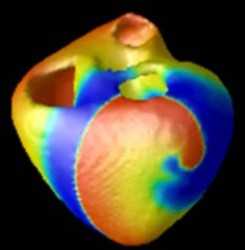May 18 2015
A virtual-heart platform proposed by Stony Brook researchers and colleagues to improve and accelerate medical-device development and testing has received funding from the National Science Foundation (NSF) in the amount of $4.2 million over five years.
 These images using the CyberHeart platform capture highly detailed multi-scale modeling and simulation of electrical patterns in the heart (spiral waves) representative of potentially fatal cardiac arrhythmias. Credit: Stony Brook University
These images using the CyberHeart platform capture highly detailed multi-scale modeling and simulation of electrical patterns in the heart (spiral waves) representative of potentially fatal cardiac arrhythmias. Credit: Stony Brook University
The “Cyberheart” project, led by Scott Smolka, a Professor of Computer Science at Stony Brook University, is part of the NSF’s center-scale initiative to advance the state-of-the-art in Cyber-Physical Systems (CPS): engineered systems that are built from, and depend upon, the seamless integration of computation and physical components. Often called the “Internet of Things,” CPS enable capabilities that go beyond the embedded systems of today.
CPS such as wearable sensors and implantable devices are already being used to assess health, improve quality of life, provide cost-effective care, and potentially speed up disease diagnosis and prevention.
The Stony Brook-led project includes collaborators from seven leading universities and centers working together to develop far more realistic cardiac and device models than currently exist. This "CyberHeart" platform can be used to test and validate medical devices faster and at a far lower cost than existing methods. CyberHeart also can be used to design optimal, patient-specific device therapies, thereby lowering the risk to the patient.
"Innovative 'virtual' design methodologies for implantable cardiac medical devices will speed device development and yield safer, more effective devices and device-based therapies, than is currently possible," said Professor Smolka."We believe that our coordinated, multi-disciplinary approach, which balances theoretical, experimental and practical concerns, will yield transformational results in medical-device design and foundations of cyber-physical system verification.”
The group's approach combines patient-specific computational models of heart dynamics with advanced mathematical techniques for analyzing how these models interact with medical devices. The analytical techniques can be used to detect potential flaws in device behavior early on during the device-design phase, before animal and human trials begin. They also can be used in a clinical setting to optimize device settings on a patient-by-patient basis before devices are implanted.
Co-investigators on the project include Edmund Clarke (Carnegie Mellon University), Elizabeth Cherry (Rochester Institute of Technology), W. Rance Cleaveland (University of Maryland), Flavio Fenton (Georgia Tech), Rahul Mangharam (University of Pennsylvania), Arnab Ray (Fraunhofer Center for Experimental Software Engineering) and James Glimm and Radu Grosu (Stony Brook University). Richard A. Gray of the FDA is another key contributor.